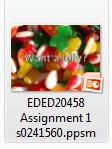A REFLECTION FROM WEEK 4
The New Media Consortium (2005) introduce the importance of multimedia to facilitate learning in an educational context, stating "a province once only occupied by artists and filmmakers is now populated by an entire generation of digital natives."
They go on to say that "young people adept at interpreting meaning in sound, music, still and moving images and interactive components not only seem quite able to cope with messages that engage several of these pathways at once, but in many cases prefer them." Prensky suggests this preference is due to the nature of the 21st century; "All the students we teach have something in their lives that's really engaging - something that they do and that they are good at, something that has an engaging, creative component to it" (Prensky, 2005).
Multimedia is a multifaceted concepts which incorporates all of the above elements. It can be used to transform learning, engage students, draw connections, organise learning material, enhance pedagogy and evoke emotion.
Is your head on the chopping block?
Images
A picture may be worth 1000 words, but it may also be 1000KB.
With so many on-line options available for presentations of student work or even assessment submission, file size is critical.
Take me for example. As assessment for another subject, I created a PowerPoint presentation.
I then went to upload it.
Uh oh!
Being aware of programs available online (such as data converters) can ensure that these issues never happen to you! MobaPhoto is a data converter which can reformat images and videos, effectively reducing file sizes.
It can even be used as subject for a maths lesson!
What % file reduction did the use of MobaPhoto result in?
79% for those of you who care.
So can images be used to enhance learning and promote higher order thinking? This website provides examples of how each level of thinking can be applied to one simple photograph!
Take the 47.4KB image I simply uploaded from my iPhone. Second to being a pizza, it can be used to provide a visual representation of a concept (eg: fractions, as slices of a pizza).
This website provides an entire mathematics dictionary, represented by static and interactive images...who said maths can't be fun?
In the context of a lesson, this visual mode would not be used in isolation. Commonly an idea/concept would be presented using a pedagogy combining written, aural and visual modes.
Swisher (2007) argues that "when pictures and words are displayed in multimedia, only the visual channel is utilized and it can easily become overloaded; when narration is presented auditorily, it can be processed by the auditory/verbal channel, allowing the visual/pictorial channel more cognitive resources to process the graphical content."
He continues in saying, "of particular interest for multimedia learning is the ability of the learner to not only build both verbal and visual modes of mental representation but also establish meaningful connections between them."
The idea here is that multimedia draws on different learning styles and multiple intelligences, which is key to student engagement. Being a visual learner myself, I do not underestimate the power of images.
References:
Prensky M. (2005). "Engage Me or Enrage Me". What Today's Learners Demand? Retrieved from: http://net.educause.edu/ir/library/pdf/erm0553.pdf
The New Media Consortium (2005). A Global Imperative - The Report of the 21st Century Literacy Summit Retrieved from: http://www.nmc.org/pdf/Global_Imperative.pdf
Swisher D. (2007). Does Multimedia Truly Enhance Learning? Moving Beyond the Visual Media Bandwagon Toward Instructional Effectiveness Retrieved from: http://www.academia.edu/1046356/Does_Multimedia_Truly_Enhance_Learning_Moving_Beyond_The_Visual_Media_Bandwagon_Toward_Instructional_Effectiveness







Hi Susan, this is a great blog site and each point is very well explained. I also had a listen to you cat. Well done.
ReplyDelete